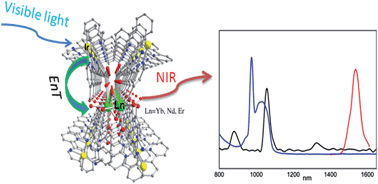Highly sensitized near-infrared luminescence in Ir–Ln heteronuclear coordination polymers via light-harvesting antenna of Ir(iii) unit†
Abstract
Four novel iridium–lanthanide heteronuclear coordination polymers {Ln[Ir(ppy)2(dcbpy)]2(OH)}·H2O (Ir–Ln; Ln = Gd, Yb, Er, Nd, ppy = 2-phenylpyridine, dcbpy = 2,2′-bipyridine-4,4′-dicarboxylate) were successfully obtained by hydrothermal reactions based on a Ir unit (Ir(ppy)2(Hdcbpy), L–H). In these complexes, the Ir unit acts as a good light-harvesting antenna showing high visible light absorption via triplet metal-to-ligand charge transfer (3MLCT), and effectively sensitizes Ln(III)-based near-infrared (NIR) luminescence by d → f energy transfer from the Ir unit to the Ln3+ ions. Those coordination polymers display the characteristic NIR emission of Ln(III) ions (Ln = Yb, Er, Nd) when being excited by 500 nm visible light, while the characteristic 3MLCT luminescence of the Ir unit was almost quenched. The Ir–Nd polymer exhibited the maximum quenching of the 3MLCT luminescence of the Ir unit because the Nd(III) ion is the most effective energy-acceptor with a high density of low-lying f–f states. The coordination polymer structures of Ir–Ln reduce the effect of high-energy oscillators (O–H, C–H) and further increase the Ln(III)-based emission lifetimes and quantum yields. The successfully acquired highly sensitized NIR luminescent Ir–Ln coordination polymers pave a new approach to the design and synthesis of NIR luminescent materials.


 Please wait while we load your content...
Please wait while we load your content...